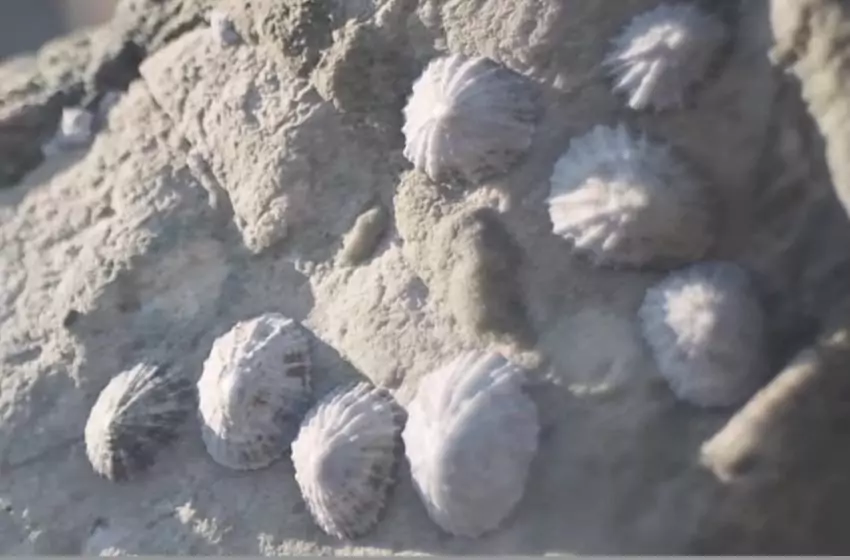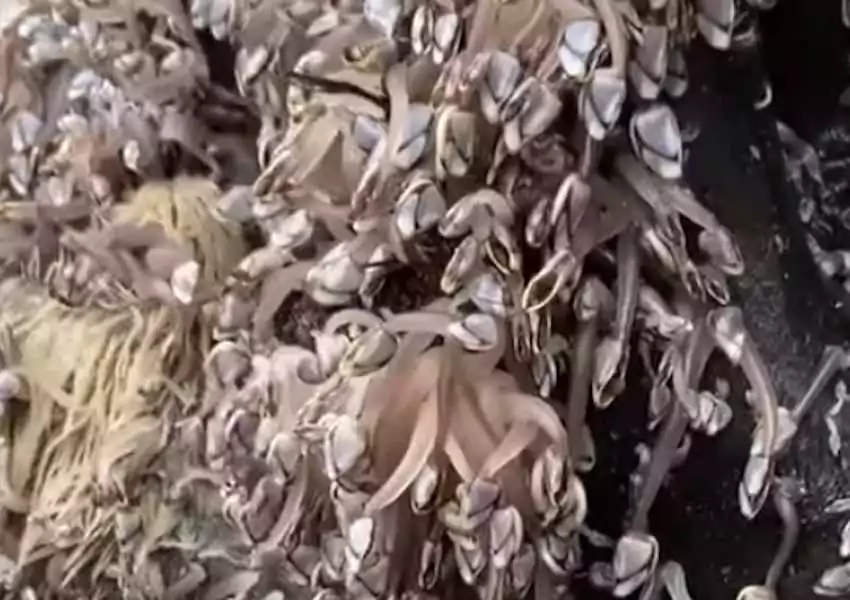Limpets and barnacles are two types of marine animals that are often confused with each other. While they may look similar at first glance, the two have several key differences.
One significant difference between limpets and barnacles is their mode of attachment. Limpets are capable of locomotion and can move around freely. At the same time, barnacles attach themselves to submerged surfaces such as tidal rocks or the bottoms of ships and cannot move once connected.
Another difference between the two is their feeding habits. Limpets are grazers and help keep algae in check, while barnacles are filter feeders that help improve water quality.
Understanding these differences is essential for those interested in marine life or encountering these animals daily.
Limpet vs. Barnacle
Limpets and barnacles are familiar marine creatures found in intertidal zones and other submerged surfaces.
While they may look similar at first glance, they have distinct characteristics that set them apart.
| Limpet | Barnacle |
|---|---|
| Small mollusc with a conical shell | Marine crustacean with a hard outer shell |
| Found clinging to rocks in intertidal zones | Attaches itself to submerged surfaces such as tidal rocks or the bottoms of ships |
| Soft body | Feeds on plankton |
| Feeds off algae |
Limpets are small mollusks with conical shells that cling to rocks in intertidal zones. They have a soft body and feed off algae. They are often found in clusters and can be a food source for other marine animals.
On the other hand, barnacles are marine crustaceans with a hard outer shell. They attach themselves to submerged surfaces such as tidal rocks or the bottoms of ships.
They feed on plankton and can be a nuisance to boats and other structures that are in the water for extended periods.
Physical Characteristics of Limpets and Barnacles
Limpet Physical Characteristics

Limpets are marine gastropods with a distinctive conical shell. Their shells are usually smooth and have a low profile, which helps them cling tightly to seashore rocks.
Limpets come in various colors, including brown, grey, white, and green. They have muscular feet that they use to move around and cling to rocks.
The physical characteristics of limpets can vary depending on the species. For example, the L. pelta species is small, measuring 5-15mm long.
It has a brown shell with white triangular markings and a lower profile than its rock form. The anterior slope of the body tends to be concave, and the cover narrows at the anterior. It has fine radial riblets and concentric lines but no prominent radiating ridges.
Limpets are herbivorous but likely also eat young barnacles and other things that settle on their home rocks. They scrape the rock’s surface with a robust and toothy organ called a radula.
It is challenging for sedentary animals or plants to establish in a limpet’s territory because it scrapes its rocks clean in a regular pattern.
Barnacle Physical Characteristics

Barnacles are marine crustaceans that have a hard, calcareous shell. They attach themselves to rocks, shells, or other hard surfaces using a cement-like substance.
Barnacles have a unique feeding mechanism, where they extend feathery appendages called cirri from their shell to catch plankton and other tiny organisms in the water.
The physical characteristics of barnacles can vary depending on the species. For example, the acorn barnacle is a common intertidal species with a conical shell with a series of plates that open and close to allow feeding.
Conversely, the goose barnacle has a long, stalk-like body with a small, triangular shell at the end.
Barnacles come in various colors, including white, grey, brown, and black. Depending on the species, they can grow up to several inches in length. They are also known for their ability to withstand extreme conditions, such as exposure to air and waves during low tide.
| Characteristic | Limpet | Barnacle |
|---|---|---|
| Shell Type | Conical | Calcareous |
| Color | Brown, Grey, White, Green | White, Grey, Brown, Black |
| Feeding Mechanism | Scrapes rock surface with radula | Extends cirri to catch plankton |
| Size | 1-4 inches | Up to several inches |
When comparing the physical characteristics of limpets and barnacles, it is clear that they have many differences.
While both are adapted to life on the seashore, they have evolved unique features that allow them to survive in their respective environments.
Limpet Habitat
The common limpet is a marine gastropod mollusk that lives in the intertidal zone along the rocky shores of Western Europe. They are found on rocks between the shore’s high and low tide areas in the intertidal zone.
Limpets can be found in various habitats, including rocky shores, tide pools, and submerged rocks. They prefer areas with good water flow and a complex, stable surface to attach to.
Common limpets are herbivorous, feeding on algae and other tiny organisms that grow on the rocks where they live. They can survive out of water for short periods, but they require a moist environment to prevent drying out in the sun.
During low tides, the common limpet’s tight seal with its rock prevents it from drying out.
Barnacle Habitat
Barnacles are crustaceans that live in the intertidal zone, attached to rocks, shells, or other hard surfaces.
They are filter feeders that feed on plankton and other tiny organisms carried by the currents. Barnacles prefer areas with good water flow and a complex, stable surface to attach to.
Barnacles can survive out of water for short periods but require a moist environment to prevent drying out. They are found in various habitats, including rocky shores, tide pools, and submerged rocks. Barnacles can also attach to ships and other artificial structures, causing damage and increasing drag.
| Limpet | Barnacle | |
|---|---|---|
| Preferred Habitat | Rocky shores with good water flow and stable surface | Rocky shores with good water flow and stable surface |
| Feeding Behavior | Herbivorous, feeding on algae and other small organisms | Filter feeder, feeding on plankton and other small organisms |
| Ability to Survive Out of Water | Short periods of time, requires moist environment to prevent drying out | Short periods of time, requires moist environment to prevent drying out |
Feeding Habits: Limpets vs. Barnacles
Limpet Feeding Habits
Limpets are herbivores that feed on algae. They use their radula, a rough tongue-like organ, to scrape algae off rocks.
They have a muscular foot that they use to cling to rocks in the intertidal zone, where they are exposed to air during low tide and submerged during high tide. When submerged, they use their gills to extract oxygen from the water.
Some species of limpets, such as the keyhole limpet, are known to feed on animal matter. They use their radula to drill a hole into the shell of their prey, such as mussels or barnacles, and provide their soft tissues.
Barnacle Feeding Habits
Barnacles are filter feeders that rely on plankton for their food. They use feather-like appendages called cirri to capture plankton from the water.
Barnacles are sessile, which means they are permanently attached to rocks, shells, or other hard surfaces. They have a hard cover that protects them from predators and desiccation during low tide.
They are hermaphrodites, which means they have both male and female reproductive organs. They release their eggs and sperm into the water, where fertilization occurs.
The larvae that hatch from the eggs are planktonic and drift in the water column until they find a suitable surface to settle on and metamorphose into adult barnacles.
Reproduction: Limpets vs. Barnacles
Limpet Reproduction
Common limpets are hermaphroditic, meaning they have both male and female reproductive organs.
However, they cannot fertilize their eggs. During mating season, limpets release their gametes into the water, where fertilization occurs. The fertilized eggs develop into free-swimming larvae, eventually settling on a suitable rock and metamorphosing into juvenile limpets.
Barnacle Reproduction
Barnacles are also hermaphroditic, but they cannot self-fertilize. During mating season, they extend their cirri (modified legs) out of their shells to search for a mate.
Once a mate is found, they use their cirri to transfer sperm to each other. The fertilized eggs develop into free-swimming larvae, which go through several molts before settling on a suitable substrate and metamorphosing into juvenile barnacles.
Barnacle reproduction is affected by various factors, including temperature, salinity, and wave action. In areas with high wave action, barnacles may reproduce more frequently to compensate for the higher mortality rates of their larvae.
Table 1 below summarizes the differences between limpet and barnacle reproduction.
| Limpet | Barnacle | |
|---|---|---|
| Reproductive organs | Hermaphroditic | Hermaphroditic |
| Self-fertilization | No | No |
| Mating | Release gametes into water | Transfer sperm using cirri |
| Larvae | Free-swimming | Free-swimming |
| Settlement | On suitable rock | On suitable substrate |
Behavior
Limpet Behavior
Limpets are known for their ability to cling onto rocks and withstand the force of waves crashing against them.
They use a muscular foot to attach themselves to surfaces and have a hard, dome-shaped shell that protects them from predators. Limpets are herbivores and feed on algae, which they scrape off rocks using a specialized tongue-like structure called a radula.
Limpets move around on the rocks when feeding, leaving distinctive grazing marks behind. They are also known for their homing behavior, which involves returning to the same spot on the rock after feeding.
This behavior is related to the need for limpets to maintain and defend a territory from other limpets.
Barnacle Behavior
Barnacles are sessile crustaceans attached to rocks, shells, and other hard surfaces. They have a hard outer shell that protects them from predators and the environment, and they feed on plankton using feather-like appendages called cirri.
Barnacles are filter feeders, and they rely on the movement of water to bring food to them. They are also known for their ability to change their feeding behavior depending on the conditions.
For example, they can adjust the length of their cirri to optimize feeding in different water currents.
One interesting behavior of barnacles is their ability to modify the behavior of other organisms that live near them.
For example, a study found that the presence of barnacles on rocks can modify the foraging behavior of limpets, causing them to spend less time feeding and more time moving around in search of food.





Leave a Reply
You must be logged in to post a comment.